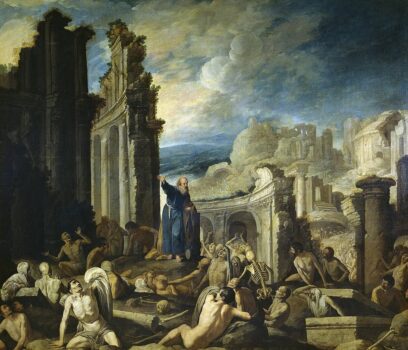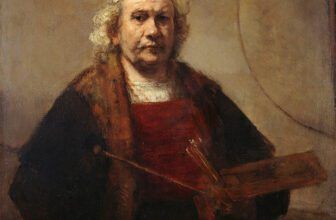Francisco de Collantes The Vision of Ezekiel
The world of Baroque art is filled with drama, spiritual intensity, and a desire to translate transcendent religious visions into tangible, earthly forms. Among the painters who contributed to this grand artistic tradition was Francisco de Collantes, a Spanish Baroque artist whose works were deeply rooted in biblical themes and spiritual narratives. One of his most compelling and theologically rich works is The Vision of Ezekiel, painted in the mid-17th century. This canvas is not only a remarkable artistic achievement but also a profound meditation on divine revelation, the mysteries of resurrection, and God’s sovereignty as revealed through the prophet Ezekiel.
To understand the full significance of this painting, one must look at several layers: the biblical story that inspired it, the historical and artistic context in which Collantes painted, the symbolism embedded in its composition, and the meaning it conveys to viewers both in its own time and today. This essay will explore The Vision of Ezekiel comprehensively, examining its story, its artistry, its symbolism, and its present-day location.
The Story Behind The Vision of Ezekiel
The painting draws directly from the Old Testament, specifically from the Book of Ezekiel, chapter 37, which recounts the extraordinary vision given to the prophet Ezekiel during the Babylonian exile of the Israelites. Ezekiel, a priest turned prophet, lived in one of the most turbulent moments of Jewish history, when Jerusalem had been conquered and its people deported to Babylon. In this setting of despair and hopelessness, God revealed to Ezekiel a symbolic vision of restoration and resurrection.
The vision is described in vivid detail: Ezekiel is transported to a valley filled with dry bones, representing the lifeless state of Israel. God asks him, “Son of man, can these bones live?” (Ezekiel 37:3). Ezekiel replies with humility and uncertainty: “O Lord God, you alone know.” Then God commands him to prophesy over the bones. As Ezekiel speaks, the bones begin to rattle, come together, and are covered with sinews and flesh. Yet they are still lifeless until God breathes His spirit into them, transforming the dry bones into a living, vast army. This vision, at once strange and awe-inspiring, symbolizes God’s promise to restore Israel from exile and hints at the broader theme of resurrection and new life.
Francisco de Collantes captures this very moment of divine transformation: the dry bones being reanimated by the power of God’s breath, the prophet Ezekiel witnessing the miracle, and the glory of heaven opening above to reveal the source of divine authority. His painting is both a literal visualization of the biblical passage and a spiritual meditation on its meaning.
Francisco de Collantes: The Artist Behind the Vision
Francisco de Collantes (1599–1656) was a Spanish Baroque painter born in Madrid. Though he is not as universally famous as contemporaries like Diego Velázquez or Francisco de Zurbarán, Collantes was highly regarded in his time for his ability to depict religious subjects with fervor and imagination. He studied under Vincenzo Carducci, a prominent Italian painter working in Spain, and quickly developed a style that combined dramatic storytelling with a keen sensitivity to landscape and atmosphere.
Collantes specialized in landscapes infused with biblical narratives, which was relatively unusual in Spanish art of the period. His ability to harmonize natural scenery with divine events gave his paintings a unique character. In The Vision of Ezekiel, he demonstrates this talent by setting the prophet’s vision within a sweeping, dramatic valley landscape, blending realism with supernatural revelation.
The painting was created around the mid-17th century and commissioned for a religious institution in Madrid. It reflects the Catholic Counter-Reformation emphasis on using art as a didactic and inspirational tool, designed to engage viewers emotionally and spiritually. Spain at this time was deeply Catholic, and religious art was seen as a medium through which scripture could come alive, reminding the faithful of God’s power and promises.
What The Vision of Ezekiel Is All About
At its core, Collantes’s The Vision of Ezekiel is about resurrection, divine power, and hope in the midst of despair. It is about the triumph of God’s spirit over death and desolation. By translating Ezekiel’s prophetic experience into visual form, Collantes invites the viewer to step into the valley of dry bones and witness God’s miracle firsthand.
The painting represents more than just the story of Israel’s return from exile; it also reflects Christian interpretations of the vision. In the Catholic tradition, Ezekiel’s vision was often read as a prefiguration of the final resurrection at the end of time, when all the dead will be raised to life by God’s spirit. In this way, the painting does not only speak to the historical plight of Israel but also addresses the universal human condition of mortality and the hope of eternal life.
Symbolism and Meaning in The Vision of Ezekiel
Collantes’s painting is loaded with symbolism, each element carefully chosen to deepen the meaning of the scene.
The Valley of Bones
The barren valley, littered with skeletal remains, symbolizes desolation, hopelessness, and death. It reflects the state of the exiled Israelites, cut off from their homeland and seemingly abandoned by God. In a broader sense, it represents humanity in its fallen state, lifeless without the breath of the divine.The Bones Coming to Life
The bones reassembling and gaining flesh illustrate the transformative power of God’s word and spirit. This visual metaphor speaks not only of national restoration for Israel but also of spiritual rebirth for all believers.Ezekiel the Prophet
Typically depicted standing in awe, pointing, or speaking as he delivers God’s prophecy, Ezekiel represents obedience and faith. His presence in the painting emphasizes the role of the prophet as a mediator between God and the people.The Heavenly Vision Above
In many depictions, including Collantes’s, the heavens open above the valley, revealing divine light, angels, or God’s throne. This symbolizes divine authority and the source of the miracle. It reassures viewers that what is happening below is not mere natural occurrence but divine intervention.Light and Darkness
Collantes employs dramatic contrasts of light and shadow, a hallmark of Baroque art. The light descending from heaven illuminates the bones being reanimated, symbolizing the infusion of divine life, while the darker areas of the valley suggest death, ignorance, and despair.The Spirit or Breath of God
Though invisible, the Spirit is symbolized by the movement and dynamism within the scene, the stirring of the bones, the gust-like arrangement of the figures, and the heavenly radiance above. This embodies the biblical idea that it is God’s spirit that animates lifeless humanity.
What Is Happening in the Painting
In Collantes’s The Vision of Ezekiel, the viewer witnesses a moment of transformation: a valley filled with bones being reanimated into living beings. The scene unfolds dramatically: bones are seen scattered, some already reassembling into skeletons, others covered in sinew and flesh, and others fully risen as living humans. The prophet Ezekiel, positioned to one side, gestures or watches in awe, embodying the human witness to divine power.
Above, the heavens break open with dazzling light, suggesting the presence of God’s glory. Angels or divine radiance may be visible, reinforcing the idea that the miracle originates from the divine realm. The composition is filled with motion and energy, as if the entire landscape is alive with God’s breath.
The painting captures not one static moment but an unfolding process, the passage from death to life, despair to hope, silence to divine proclamation. It is narrative painting at its finest, compressing time and action into a single visual experience.
The Artistic Style: What Type of Art Is The Vision of Ezekiel Painting?
The Vision of Ezekiel is quintessentially a Baroque religious painting. Baroque art, flourishing in 17th-century Europe, was characterized by dramatic contrasts of light and shadow, emotional intensity, dynamic compositions, and an aim to move the viewer spiritually and emotionally.
Collantes employs these Baroque elements masterfully:
Dramatic Lighting: The divine light descending from above contrasts with the shadowed valley, heightening the sense of supernatural presence.
Dynamic Composition: The swirling motion of bones, bodies, and figures conveys energy and movement.
Emotional Impact: The astonishment of Ezekiel and the grandeur of the miracle are designed to inspire awe and devotion in the viewer.
Theatricality: Like many Baroque works, the painting has a staged quality, drawing the viewer into the drama as if it were unfolding live.
At the same time, Collantes’s distinctive strength as a landscape painter is evident. The valley is not just a backdrop but an active participant in the story, vast and echoing with the presence of both death and new life.
The Location of The Vision of Ezekiel Painting
The Vision of Ezekiel by Francisco de Collantes is housed in the Museo del Prado in Madrid, Spain, one of the world’s greatest art museums and the most important collection of Spanish Baroque painting. The Prado’s galleries contain masterpieces by Velázquez, Zurbarán, Murillo, and El Greco, and Collantes’s work stands among them as a testament to the rich diversity of Spanish Baroque art.
The painting continues to be studied by art historians and admired by visitors for its powerful storytelling and profound theological symbolism. For modern audiences, it offers not only a glimpse into the religious imagination of 17th-century Spain but also a timeless meditation on life, death, and hope.
The Meaning of Collantes’s Vision
Francisco de Collantes’s The Vision of Ezekiel is far more than an illustration of a biblical passage. It is a layered meditation on divine power, human mortality, and the promise of renewal. It captures a story rooted in Israel’s exile while simultaneously speaking to universal themes of resurrection and restoration.
Through his masterful Baroque style, Collantes brings the vision to life with theatricality, intensity, and symbolism. The valley of dry bones becomes not only a place of death but also a stage for God’s life-giving spirit to act. The painting reassures viewers that despair and desolation are never the final word, for God’s breath can bring new life even to the most hopeless situations.
The Vision of Ezekiel by Francisco de Collantes is both a masterpiece of Spanish Baroque art and a profound theological statement. Its story, symbolism, and artistry continue to resonate centuries after it was painted, inviting each viewer to step into the prophet’s vision and witness the miracle of divine restoration.




